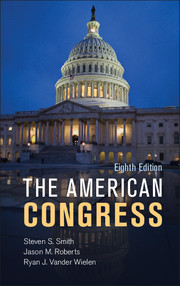Book contents
- Frontmatter
- Contents
- PREFACE
- Acknowledgments
- 1 The Troubled Congress
- 2 Representation and Lawmaking in Congress
- 3 Congressional Elections and Policy Alignments
- 4 Members, Goals, Resources, and Strategies
- 5 Parties and Leaders
- 6 The Standing Committees
- 7 The Rules of the Legislative Game
- 8 The Floor and Voting
- 9 Congress and the President
- 10 Congress and the Courts
- 11 Congress, Lobbyists, and Interest Groups
- 12 Congress and Budget Politics
- Appendix Introduction to the Spatial Theory of Legislating
- Index
3 - Congressional Elections and Policy Alignments
- Frontmatter
- Contents
- PREFACE
- Acknowledgments
- 1 The Troubled Congress
- 2 Representation and Lawmaking in Congress
- 3 Congressional Elections and Policy Alignments
- 4 Members, Goals, Resources, and Strategies
- 5 Parties and Leaders
- 6 The Standing Committees
- 7 The Rules of the Legislative Game
- 8 The Floor and Voting
- 9 Congress and the President
- 10 Congress and the Courts
- 11 Congress, Lobbyists, and Interest Groups
- 12 Congress and Budget Politics
- Appendix Introduction to the Spatial Theory of Legislating
- Index
Summary
2012 marked a return to normalcy in congressional elections after consecutive elections with large seat shifts from one party to the other. In the 2006 midterm elections, Republicans lost large numbers of House and Senate seats, which caused them to lose control of both chambers for the first time since 1995. In 2008, Democrats, led by a strong presidential candidate in Barack Obama, added to their House and Senate majorities, even briefly enjoying a so-called filibuster-proof or sixty-seat majority in the Senate. In 2010, the tables were turned as Republicans gained sixty-five House seats and majority control of the chamber, and narrowed the Democratic Party’s margin in the Senate. The 2006 and 2010 elections continued a long-standing pattern of midterm elections being electorally unfavorable for the party of the president, whereas 2008 was, in some ways, consistent with the so-called coattail effect that sees a surge in seat gains for the party of a newly elected president. In 2012, Democrats gained seats in both the House and Senate elections, but failed to win enough House seats to recapture the majority. As such, the 113th Congress began with the same partisan alignment as was present for the 112th Congress.
The 2006, 2008, and 2010 election cycles stand out among elections in the past few decades in that national-level issues dominated the discussion in many states and districts. In 2006 and 2008, Republicans were weighed down by the declining popularity of President George W. Bush, based in large part on the public’s declining view of the war in Iraq in 2006, and the nation’s economic collapse in 2008. In 2010, the public’s ire over high unemployment rates and slow economic growth dragged down President Barack Obama’s approval ratings and disproportionately affected many Democratic congressional candidates. In 2012, elections were more congruent than ever. In fact, the correlation between the House vote and the presidential vote reached an all-time high in 2012.
- Type
- Chapter
- Information
- The American Congress , pp. 59 - 92Publisher: Cambridge University PressPrint publication year: 2013

